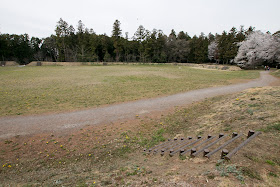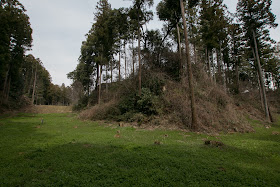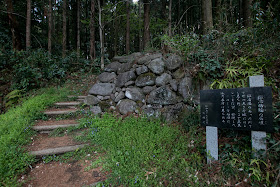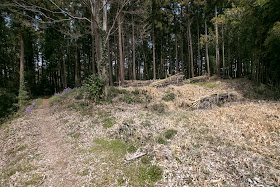Minowa Castle
-Regional hub castle modified by each holder-
Overview
Name: Minowa castle (Minowa-jo)
Alias:
Place: Misato town Takasaki city, Gunma
Location: 36.404323778294724, 138.95165570760665
Type: Hill castle
Built: Originally 1512, expanded in 16th century
Remaining remnants: Stone walls, clay walls and dry moats
Title: 100 famous Japanese castles
Minowa castle (箕輪城) is located on the hill of 30 meter high from its hillside at the end of long ridge continued from Mt. Haruna toward southwest at former Misato town in the northwestern part of Takasaki city.
Historically Takasaki area is an important crossing point of Nakasendo road which runs westward at southern edge of Mt. Haruna toward Shinano province (Nagano prefecture) crossing Usui Toge pass and Mikuni Kaido road proceeds northward to Echigo province (Niigata prefecture) over Mikuni Toge pass. In addition to the location which was able to control both roads, a long and narrow hill protected its by side by deep valley of Haruna-Shirakawa river was an ideal place to build a castle.
Historically this area was goverened by local lord Nagano clan. Nagano clan is said as a descendant of Narihira Ariwasa (825-880), an ancient noble and famous Waka (Japanese verse) artist. Apart from the truth of this story, Nagano clan grew their power in Muromachi era and became the leader of local lords in western part of Kouzuke province (Gunma prefecture). Nagano clan also built Minowa castle as their residence in 1512.
In 1545, Norimasa Uesugi (1523-1579), who traditionally held status of Kanto Kanrei (general lord of Kanto region) and master of Nagano clan, suffered severe defeat by Ujiyasu Hojo (1515-1571) who was the lord of Odawara castle (Kanagawa prefecture) at the battle of Kawagoe castle in 1546. Further Norimasa sent a reinforce army to the local lords of Saku region of Shinano province (Nagano prefecture) next to Kouzuke province attacked by Shingen Takeda (1521-1573), the warlord of Kai province (Yamanashi prefecture) but this army also suffered critical lost before Kenshin in 1547.
Continuous defeats decreased the fame and power of Uesugi clan. Norimasa and lost territories in Musashi province (Tokyo metropolis and Saitama prefecture), and his residence Shirai castle (Gunma prefecture) became exposed to the enemy by 1550. Norimasa asked assistance of Kagetora Nagao (1530-1578, later Kenshin Uesugi), a warlord of Echigo province (Niigata prefecture) and escaped to there.
The leader of Nagano clan at that time was Narimasa Nagano (1491-1561). After the leave of Norimasa from Kozuke province, Narimasa piled up local lords of this area and once served to Hojyo clan. But in 1560, Kenshin Uesugi started his campaign against Hojo clan using the name of Norimasa Uesugi, and invaded into Kozuke province across Mikuni Toge pass. At this time Narimasa turned to Uesugi side again, and Kenshin once reached to Odawara castle, the main base of Hojo clan but could not fall it and retreated.
At this year, Shingen Takeda who already held Shinano province (Nagano prefecture) started invasion to Kouzuke province. To fight with remaining Uesugi army, Hojo clan might acknowledge Shingen's invasion to Kozuke province. Facing the attack of Shingen, Narimasa well organized neighbor lords and continued to strike back Takeda army by guerrilla tactics from Minowa castle. It is said that Shingen sighed that as long as Narimasa was alive, he could not seize Kouzuke province.
But in 1561, Narimasa died in ill. Narimasa made the will for his son Narimori to resist against Shingen to the last man. Narimori also well fought against Shingen over five years, but due to the one by one attack and invitation of Shingen, Nagano clan gradually lost supporting local lords under them. Finally, in 1566, isolated Nagano clan was besieged at Minowa castle by 20,000 Takeda soldiers, and after desperate fight Narimori and his relative killed themselves at inner part of Minowa castle.
After the fall of Minowa castle, Shingen used Minowa castle as a regional base at Kozuke province and appointed his excellent generals such as Yukitaka Sanada (1513-1574), Nobutane Asari (?-1569) and Masahide Naito (1522-1575, famous as the name of Masatoyo) as a commander of this castle. Especially Masahide Naito was a excellent general regarded as vice leader of Takeda clan, and later recognized as one of four famous generals of Takeda army. Takeda clan built Maru Umadashi (half rounded buffer area with crescent shaped dry moat in front of gate) at northeastern edge of castle, one of the weak point of the castle. But Masatoyo died in the battle of Nagashino against Oda clan in 1575.
Seven year after Takeda clan was extinguished by central ruler Nobunaga Oda (1534-1582) in 1582, and Nobunaga placed his important general Kazumasu Takigawa (1525-1586) as the lord of Kozuke province. Minowa castle once belonged to Kazumasu, but Oda clan lost their leader Nobunaga Oda (1534-1582) in the accident of Honnoji three month later.
Hearing this news Hojo clan broke Kazumasu Takigawa at the battle of Kannagawa river and captured Kozuke province including Minowa castle. Hojo clan also recognized Minowa castle as an important base of the area and significantly reformed it utilizing their technology.
Minowa castle spreads over a long and narrow hill of 800 meter long and 200 meter wide continues north and southward, having two small ridge at its south end. Roughly the castle consist of three layer of terraces spreads concentrically from the top of the hill.
Most inner one is a line of areas such as Gozenguruwa (inner area), central area and secondary area. These areas might be the original one from the era of Nagano clan, and rough slope of the north line of Gozenguruwa might keep the first shape of the castle.
Middle layer areas are the ones such as Inariguruwa, Toorinakaguruwa, Kajiguruwa and third area surround core areas. These areas are built utilizing the edge of the hill and have steep slopes toward outside. Core area and middle layer areas are separated by huge dry moat, which have 20 meter wide and 10 meter depth.
Type: Hill castle
Built: Originally 1512, expanded in 16th century
Remaining remnants: Stone walls, clay walls and dry moats
Title: 100 famous Japanese castles
Brief History
Minowa castle (箕輪城) is located on the hill of 30 meter high from its hillside at the end of long ridge continued from Mt. Haruna toward southwest at former Misato town in the northwestern part of Takasaki city.
Historically Takasaki area is an important crossing point of Nakasendo road which runs westward at southern edge of Mt. Haruna toward Shinano province (Nagano prefecture) crossing Usui Toge pass and Mikuni Kaido road proceeds northward to Echigo province (Niigata prefecture) over Mikuni Toge pass. In addition to the location which was able to control both roads, a long and narrow hill protected its by side by deep valley of Haruna-Shirakawa river was an ideal place to build a castle.
Minowa castle and Narimasa Nagano
Historically this area was goverened by local lord Nagano clan. Nagano clan is said as a descendant of Narihira Ariwasa (825-880), an ancient noble and famous Waka (Japanese verse) artist. Apart from the truth of this story, Nagano clan grew their power in Muromachi era and became the leader of local lords in western part of Kouzuke province (Gunma prefecture). Nagano clan also built Minowa castle as their residence in 1512.
In 1545, Norimasa Uesugi (1523-1579), who traditionally held status of Kanto Kanrei (general lord of Kanto region) and master of Nagano clan, suffered severe defeat by Ujiyasu Hojo (1515-1571) who was the lord of Odawara castle (Kanagawa prefecture) at the battle of Kawagoe castle in 1546. Further Norimasa sent a reinforce army to the local lords of Saku region of Shinano province (Nagano prefecture) next to Kouzuke province attacked by Shingen Takeda (1521-1573), the warlord of Kai province (Yamanashi prefecture) but this army also suffered critical lost before Kenshin in 1547.
Continuous defeats decreased the fame and power of Uesugi clan. Norimasa and lost territories in Musashi province (Tokyo metropolis and Saitama prefecture), and his residence Shirai castle (Gunma prefecture) became exposed to the enemy by 1550. Norimasa asked assistance of Kagetora Nagao (1530-1578, later Kenshin Uesugi), a warlord of Echigo province (Niigata prefecture) and escaped to there.
Resistance against Takeda clan and fall
The leader of Nagano clan at that time was Narimasa Nagano (1491-1561). After the leave of Norimasa from Kozuke province, Narimasa piled up local lords of this area and once served to Hojyo clan. But in 1560, Kenshin Uesugi started his campaign against Hojo clan using the name of Norimasa Uesugi, and invaded into Kozuke province across Mikuni Toge pass. At this time Narimasa turned to Uesugi side again, and Kenshin once reached to Odawara castle, the main base of Hojo clan but could not fall it and retreated.
At this year, Shingen Takeda who already held Shinano province (Nagano prefecture) started invasion to Kouzuke province. To fight with remaining Uesugi army, Hojo clan might acknowledge Shingen's invasion to Kozuke province. Facing the attack of Shingen, Narimasa well organized neighbor lords and continued to strike back Takeda army by guerrilla tactics from Minowa castle. It is said that Shingen sighed that as long as Narimasa was alive, he could not seize Kouzuke province.
But in 1561, Narimasa died in ill. Narimasa made the will for his son Narimori to resist against Shingen to the last man. Narimori also well fought against Shingen over five years, but due to the one by one attack and invitation of Shingen, Nagano clan gradually lost supporting local lords under them. Finally, in 1566, isolated Nagano clan was besieged at Minowa castle by 20,000 Takeda soldiers, and after desperate fight Narimori and his relative killed themselves at inner part of Minowa castle.
Castle under Takeda and Hojyo clan
After the fall of Minowa castle, Shingen used Minowa castle as a regional base at Kozuke province and appointed his excellent generals such as Yukitaka Sanada (1513-1574), Nobutane Asari (?-1569) and Masahide Naito (1522-1575, famous as the name of Masatoyo) as a commander of this castle. Especially Masahide Naito was a excellent general regarded as vice leader of Takeda clan, and later recognized as one of four famous generals of Takeda army. Takeda clan built Maru Umadashi (half rounded buffer area with crescent shaped dry moat in front of gate) at northeastern edge of castle, one of the weak point of the castle. But Masatoyo died in the battle of Nagashino against Oda clan in 1575.
Seven year after Takeda clan was extinguished by central ruler Nobunaga Oda (1534-1582) in 1582, and Nobunaga placed his important general Kazumasu Takigawa (1525-1586) as the lord of Kozuke province. Minowa castle once belonged to Kazumasu, but Oda clan lost their leader Nobunaga Oda (1534-1582) in the accident of Honnoji three month later.
Hearing this news Hojo clan broke Kazumasu Takigawa at the battle of Kannagawa river and captured Kozuke province including Minowa castle. Hojo clan also recognized Minowa castle as an important base of the area and significantly reformed it utilizing their technology.
Structure of Minowa castle
Minowa castle spreads over a long and narrow hill of 800 meter long and 200 meter wide continues north and southward, having two small ridge at its south end. Roughly the castle consist of three layer of terraces spreads concentrically from the top of the hill.
Most inner one is a line of areas such as Gozenguruwa (inner area), central area and secondary area. These areas might be the original one from the era of Nagano clan, and rough slope of the north line of Gozenguruwa might keep the first shape of the castle.
Middle layer areas are the ones such as Inariguruwa, Toorinakaguruwa, Kajiguruwa and third area surround core areas. These areas are built utilizing the edge of the hill and have steep slopes toward outside. Core area and middle layer areas are separated by huge dry moat, which have 20 meter wide and 10 meter depth.
At the south edge of third area and secondary area there is a huge dry moat which cut offs the hill into north half and south half, and this is the final defense line of the castle. Hojo clan built a huge Kakuumadashi (square shaped buffer area), as a starting point of counter attack.
Third layer areas are built at south half of the hill and surrounding hillside flat areas. Many flat terraces might be used as a residence of retainers or camping place of soldiers. Front gate of the castle originally existed at southwestern edge of the hill, but later a huge masugata style gate was built ahead of former main gate next to the river. Finally total size of the castle including outer fort reached to 1,200 meter long and 400 meter wide, which was by far the largest one at the province.
Hojo clan kept Minowa castle by 1590, but at that year central ruler Hideyoshi Toyotomi (1537-1598) sent large army to Hojo clan and ruined it. At this campaign Hojo clan planned to resist against Toyotomi army which proceeds Nakasendo road from Shinano province at Minowa castle, but guardians of Minowa castle revolted and expelled the commander, and opened the castle.
Subsequent to the campaign Kanto region was given to Ieyasu Tokugawa (1543-1616), and Ieyasu appointed his confident general Naomsasa Ii (1561-1602) as a commander of Minowa castle. Naomasa served to Ieyasu as a valet from his youth, and after growth he made a name of brave for himself leading red colored armor troops. He also had intelligence and made achievements in negotiations or diplomacy.
As a base of governance, Naomasa significantly expanded this castle. Naomasa dig the deep and wide dry moats surrounding central areas, and piled up layer of central areas by surplus sand. Stone walls were also built for gates and walls along the main route from hillside to central areas passing Kotomon gate, Kajiguruwa area, third area, secondary area to central area, as sign of authority.
In 1598, Naomasa newly built Takasaki castle and moved there, as Takasaki area is a diverging point of Nakasendo road and Mikuni-Kaido road, and also manageable river transportation of Karasugawa river. Minowa castle was abolished at that time and had not used any more.
Third layer areas are built at south half of the hill and surrounding hillside flat areas. Many flat terraces might be used as a residence of retainers or camping place of soldiers. Front gate of the castle originally existed at southwestern edge of the hill, but later a huge masugata style gate was built ahead of former main gate next to the river. Finally total size of the castle including outer fort reached to 1,200 meter long and 400 meter wide, which was by far the largest one at the province.
Further expansion under Naomasa Ii and abolishment
Hojo clan kept Minowa castle by 1590, but at that year central ruler Hideyoshi Toyotomi (1537-1598) sent large army to Hojo clan and ruined it. At this campaign Hojo clan planned to resist against Toyotomi army which proceeds Nakasendo road from Shinano province at Minowa castle, but guardians of Minowa castle revolted and expelled the commander, and opened the castle.
Subsequent to the campaign Kanto region was given to Ieyasu Tokugawa (1543-1616), and Ieyasu appointed his confident general Naomsasa Ii (1561-1602) as a commander of Minowa castle. Naomasa served to Ieyasu as a valet from his youth, and after growth he made a name of brave for himself leading red colored armor troops. He also had intelligence and made achievements in negotiations or diplomacy.
As a base of governance, Naomasa significantly expanded this castle. Naomasa dig the deep and wide dry moats surrounding central areas, and piled up layer of central areas by surplus sand. Stone walls were also built for gates and walls along the main route from hillside to central areas passing Kotomon gate, Kajiguruwa area, third area, secondary area to central area, as sign of authority.
Afterward of castle
In 1598, Naomasa newly built Takasaki castle and moved there, as Takasaki area is a diverging point of Nakasendo road and Mikuni-Kaido road, and also manageable river transportation of Karasugawa river. Minowa castle was abolished at that time and had not used any more.
Now shapes of the castle well remain in deep forest, and enhancement of the ruin is gradually proceeding. Numerous terraces spreads over whole part of the hill and protected by layer of deep dry moats shows unchanged strategic importance of the castle and long time construction in spite of short term change of soldiers.
25 minutes drive from Kanetsu Expressway Takasaki interchange. 20 minutes walk from Gunma bus Misato Eigyosho bus stop from Takasaki station or Maebashi station
Takasaki Castle -Twin castles at twin cities-
Access
25 minutes drive from Kanetsu Expressway Takasaki interchange. 20 minutes walk from Gunma bus Misato Eigyosho bus stop from Takasaki station or Maebashi station
Related Castles
Takasaki Castle -Twin castles at twin cities-



















































































































































































































































































































































































































































No comments:
Post a Comment